Managing Culture and Workforce Diversity in Indian Call Centers: A Focus on HRM and Training
VerifiedAdded on 2023/04/25
|16
|4893
|492
AI Summary
Explore the impact of culture and workforce diversity on human resource management in Indian call centers, along with training and development strategies.
Contribute Materials
Your contribution can guide someone’s learning journey. Share your
documents today.
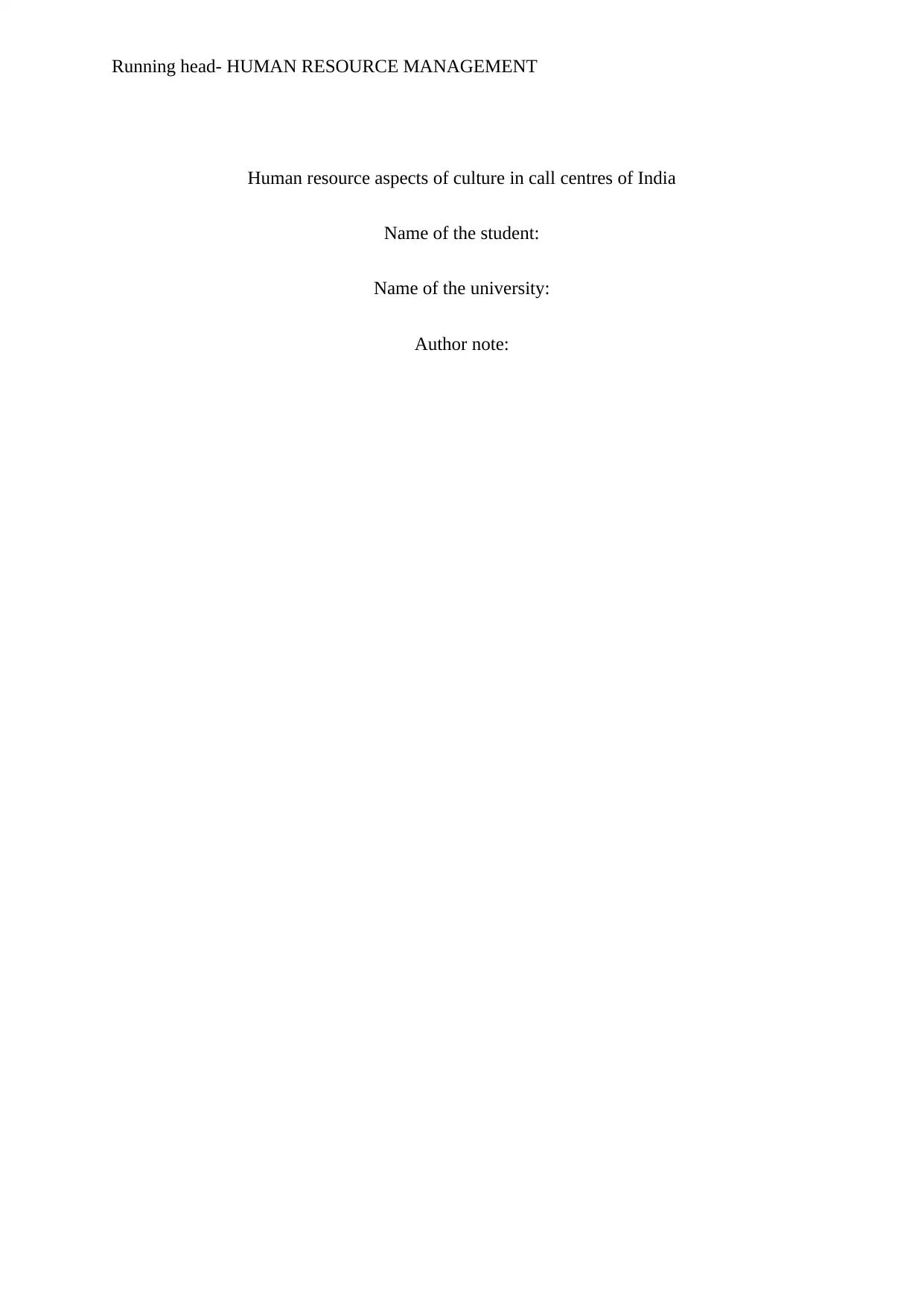
Running head- HUMAN RESOURCE MANAGEMENT
Human resource aspects of culture in call centres of India
Name of the student:
Name of the university:
Author note:
Human resource aspects of culture in call centres of India
Name of the student:
Name of the university:
Author note:
Secure Best Marks with AI Grader
Need help grading? Try our AI Grader for instant feedback on your assignments.
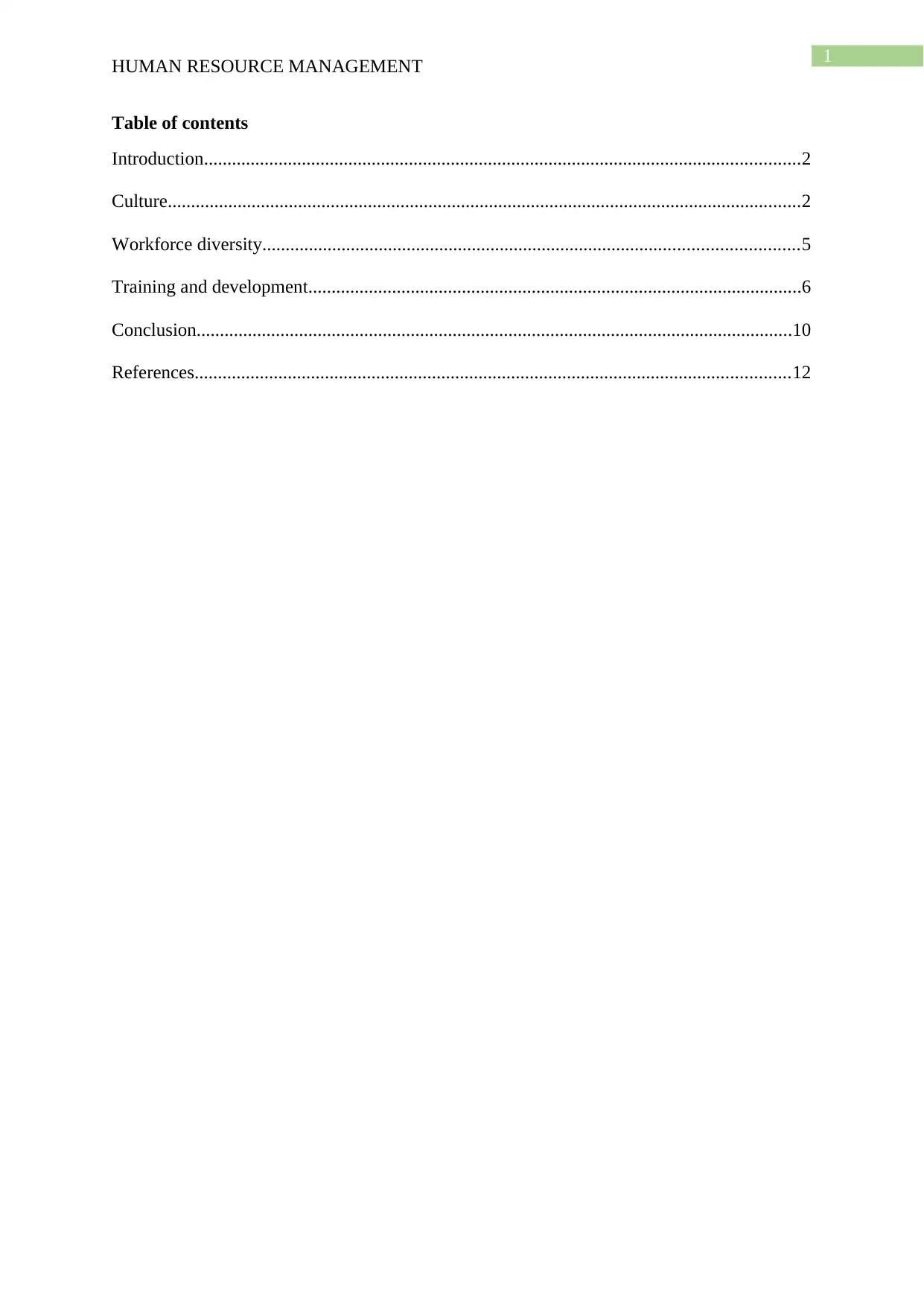
1
HUMAN RESOURCE MANAGEMENT
Table of contents
Introduction................................................................................................................................2
Culture........................................................................................................................................2
Workforce diversity...................................................................................................................5
Training and development..........................................................................................................6
Conclusion................................................................................................................................10
References................................................................................................................................12
HUMAN RESOURCE MANAGEMENT
Table of contents
Introduction................................................................................................................................2
Culture........................................................................................................................................2
Workforce diversity...................................................................................................................5
Training and development..........................................................................................................6
Conclusion................................................................................................................................10
References................................................................................................................................12
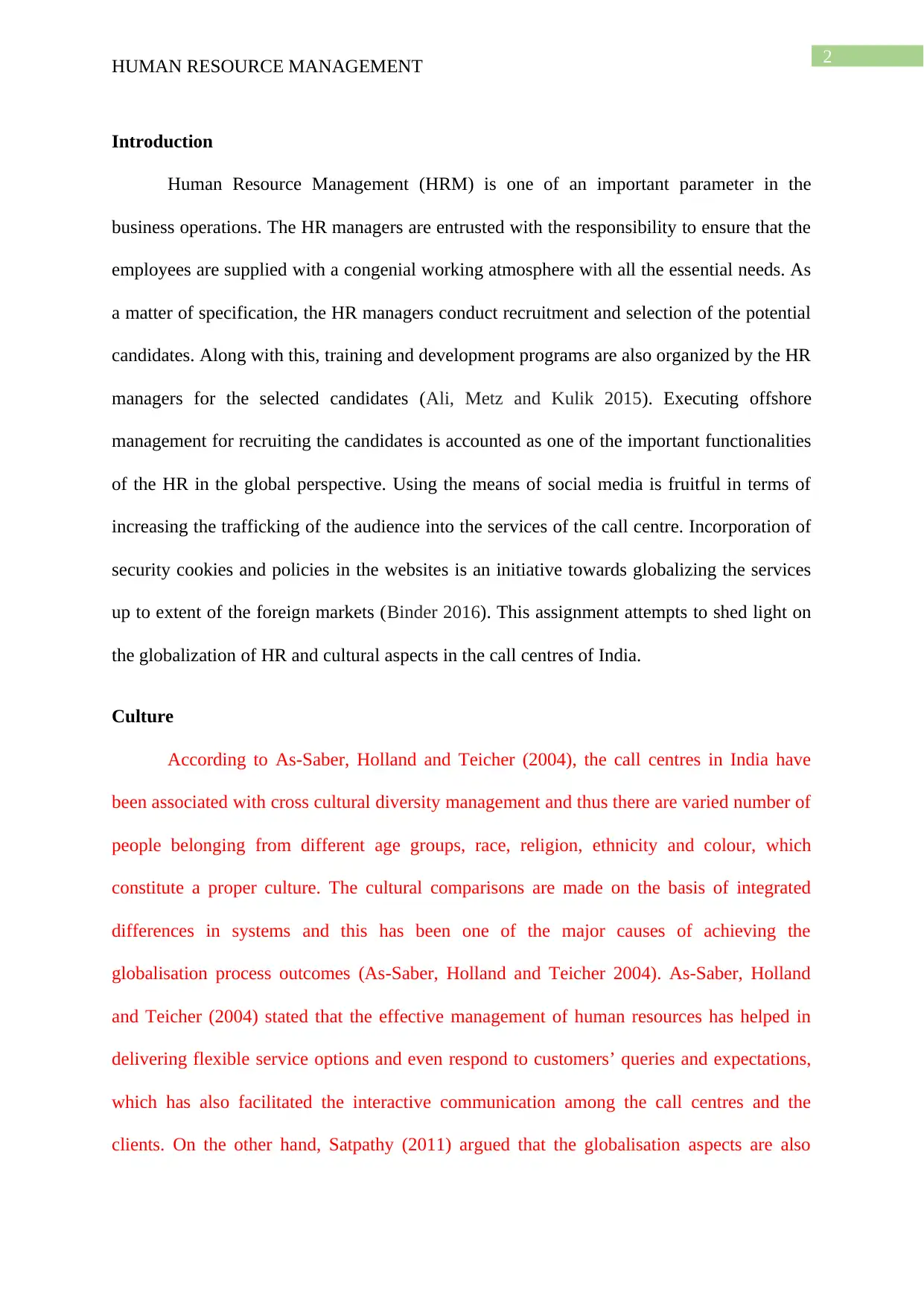
2
HUMAN RESOURCE MANAGEMENT
Introduction
Human Resource Management (HRM) is one of an important parameter in the
business operations. The HR managers are entrusted with the responsibility to ensure that the
employees are supplied with a congenial working atmosphere with all the essential needs. As
a matter of specification, the HR managers conduct recruitment and selection of the potential
candidates. Along with this, training and development programs are also organized by the HR
managers for the selected candidates (Ali, Metz and Kulik 2015). Executing offshore
management for recruiting the candidates is accounted as one of the important functionalities
of the HR in the global perspective. Using the means of social media is fruitful in terms of
increasing the trafficking of the audience into the services of the call centre. Incorporation of
security cookies and policies in the websites is an initiative towards globalizing the services
up to extent of the foreign markets (Binder 2016). This assignment attempts to shed light on
the globalization of HR and cultural aspects in the call centres of India.
Culture
According to As-Saber, Holland and Teicher (2004), the call centres in India have
been associated with cross cultural diversity management and thus there are varied number of
people belonging from different age groups, race, religion, ethnicity and colour, which
constitute a proper culture. The cultural comparisons are made on the basis of integrated
differences in systems and this has been one of the major causes of achieving the
globalisation process outcomes (As-Saber, Holland and Teicher 2004). As-Saber, Holland
and Teicher (2004) stated that the effective management of human resources has helped in
delivering flexible service options and even respond to customers’ queries and expectations,
which has also facilitated the interactive communication among the call centres and the
clients. On the other hand, Satpathy (2011) argued that the globalisation aspects are also
HUMAN RESOURCE MANAGEMENT
Introduction
Human Resource Management (HRM) is one of an important parameter in the
business operations. The HR managers are entrusted with the responsibility to ensure that the
employees are supplied with a congenial working atmosphere with all the essential needs. As
a matter of specification, the HR managers conduct recruitment and selection of the potential
candidates. Along with this, training and development programs are also organized by the HR
managers for the selected candidates (Ali, Metz and Kulik 2015). Executing offshore
management for recruiting the candidates is accounted as one of the important functionalities
of the HR in the global perspective. Using the means of social media is fruitful in terms of
increasing the trafficking of the audience into the services of the call centre. Incorporation of
security cookies and policies in the websites is an initiative towards globalizing the services
up to extent of the foreign markets (Binder 2016). This assignment attempts to shed light on
the globalization of HR and cultural aspects in the call centres of India.
Culture
According to As-Saber, Holland and Teicher (2004), the call centres in India have
been associated with cross cultural diversity management and thus there are varied number of
people belonging from different age groups, race, religion, ethnicity and colour, which
constitute a proper culture. The cultural comparisons are made on the basis of integrated
differences in systems and this has been one of the major causes of achieving the
globalisation process outcomes (As-Saber, Holland and Teicher 2004). As-Saber, Holland
and Teicher (2004) stated that the effective management of human resources has helped in
delivering flexible service options and even respond to customers’ queries and expectations,
which has also facilitated the interactive communication among the call centres and the
clients. On the other hand, Satpathy (2011) argued that the globalisation aspects are also

3
HUMAN RESOURCE MANAGEMENT
reflected within the cultural heterogeneity and has even transformed the labour markets to get
organised effectively. The cultural aspects not only include some noble intentions to provide
good employment scopes and opportunities for the people to work at the call centre and at the
same time, fulfil their regular needs and preferences to prevent any gaps that can make them
face struggles to attain the desired positive image among others within the workplace
(Satpathy 2011). To maintain a good social culture, the English language has been integrated
in both political and social spheres to ensure that the issues of status quo and language
difference problems faced in Indian call centres are overcome, furthermore allow the workers
of call centres to manage the identities of Americans through actualisation and identity
management. This has also resulted in forming a linguistic capital based on the Indian
perspective and prevent loss of authenticity and cultural insecurities. Satpathy (2011) also
claimed that the formation of a good culture and engaging different types of employees
within the workforce has also led to the higher level of satisfaction among theirs and even
kept them motivated to perform to their best potential.
The culture consists of five major dimensions including the social-cultural theory,
communication, language, values and attitudes and the religion. Considering the social
cultural aspects, two theories that are considered include Hofstede’s theory and trompenaars’
theory (Bratton and Gold 2017). As stated by Nistor et al. (2014), the cultural integration into
the theory of acceptance and use of technologies has further lead to the formation of a good
workforce with flexible work arrangements and setting the culture based on the geographical
locations. With the call centres in India becoming more ambiguous, the cultural aspects are
defined with the use of five major dimensions where the power distance index represented the
less powerful individuals, i.e., those who possess less authority and control within the
workplace culture and are liable to gain acceptance of power distribution on an unequal basis
though (Nistor et al. 2014). The uncertainties are needed to be overcome within the
HUMAN RESOURCE MANAGEMENT
reflected within the cultural heterogeneity and has even transformed the labour markets to get
organised effectively. The cultural aspects not only include some noble intentions to provide
good employment scopes and opportunities for the people to work at the call centre and at the
same time, fulfil their regular needs and preferences to prevent any gaps that can make them
face struggles to attain the desired positive image among others within the workplace
(Satpathy 2011). To maintain a good social culture, the English language has been integrated
in both political and social spheres to ensure that the issues of status quo and language
difference problems faced in Indian call centres are overcome, furthermore allow the workers
of call centres to manage the identities of Americans through actualisation and identity
management. This has also resulted in forming a linguistic capital based on the Indian
perspective and prevent loss of authenticity and cultural insecurities. Satpathy (2011) also
claimed that the formation of a good culture and engaging different types of employees
within the workforce has also led to the higher level of satisfaction among theirs and even
kept them motivated to perform to their best potential.
The culture consists of five major dimensions including the social-cultural theory,
communication, language, values and attitudes and the religion. Considering the social
cultural aspects, two theories that are considered include Hofstede’s theory and trompenaars’
theory (Bratton and Gold 2017). As stated by Nistor et al. (2014), the cultural integration into
the theory of acceptance and use of technologies has further lead to the formation of a good
workforce with flexible work arrangements and setting the culture based on the geographical
locations. With the call centres in India becoming more ambiguous, the cultural aspects are
defined with the use of five major dimensions where the power distance index represented the
less powerful individuals, i.e., those who possess less authority and control within the
workplace culture and are liable to gain acceptance of power distribution on an unequal basis
though (Nistor et al. 2014). The uncertainties are needed to be overcome within the
Secure Best Marks with AI Grader
Need help grading? Try our AI Grader for instant feedback on your assignments.
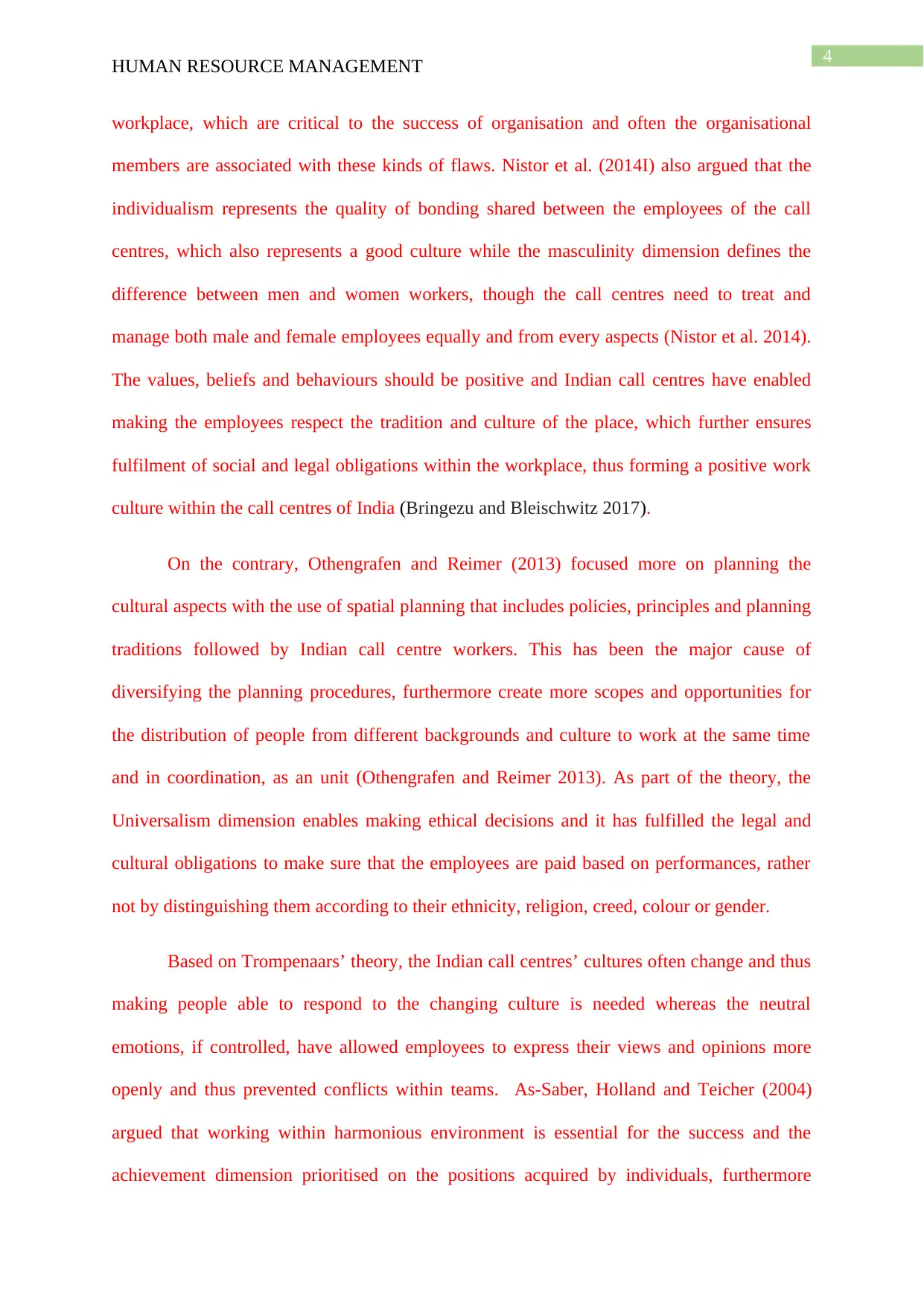
4
HUMAN RESOURCE MANAGEMENT
workplace, which are critical to the success of organisation and often the organisational
members are associated with these kinds of flaws. Nistor et al. (2014I) also argued that the
individualism represents the quality of bonding shared between the employees of the call
centres, which also represents a good culture while the masculinity dimension defines the
difference between men and women workers, though the call centres need to treat and
manage both male and female employees equally and from every aspects (Nistor et al. 2014).
The values, beliefs and behaviours should be positive and Indian call centres have enabled
making the employees respect the tradition and culture of the place, which further ensures
fulfilment of social and legal obligations within the workplace, thus forming a positive work
culture within the call centres of India (Bringezu and Bleischwitz 2017).
On the contrary, Othengrafen and Reimer (2013) focused more on planning the
cultural aspects with the use of spatial planning that includes policies, principles and planning
traditions followed by Indian call centre workers. This has been the major cause of
diversifying the planning procedures, furthermore create more scopes and opportunities for
the distribution of people from different backgrounds and culture to work at the same time
and in coordination, as an unit (Othengrafen and Reimer 2013). As part of the theory, the
Universalism dimension enables making ethical decisions and it has fulfilled the legal and
cultural obligations to make sure that the employees are paid based on performances, rather
not by distinguishing them according to their ethnicity, religion, creed, colour or gender.
Based on Trompenaars’ theory, the Indian call centres’ cultures often change and thus
making people able to respond to the changing culture is needed whereas the neutral
emotions, if controlled, have allowed employees to express their views and opinions more
openly and thus prevented conflicts within teams. As-Saber, Holland and Teicher (2004)
argued that working within harmonious environment is essential for the success and the
achievement dimension prioritised on the positions acquired by individuals, furthermore
HUMAN RESOURCE MANAGEMENT
workplace, which are critical to the success of organisation and often the organisational
members are associated with these kinds of flaws. Nistor et al. (2014I) also argued that the
individualism represents the quality of bonding shared between the employees of the call
centres, which also represents a good culture while the masculinity dimension defines the
difference between men and women workers, though the call centres need to treat and
manage both male and female employees equally and from every aspects (Nistor et al. 2014).
The values, beliefs and behaviours should be positive and Indian call centres have enabled
making the employees respect the tradition and culture of the place, which further ensures
fulfilment of social and legal obligations within the workplace, thus forming a positive work
culture within the call centres of India (Bringezu and Bleischwitz 2017).
On the contrary, Othengrafen and Reimer (2013) focused more on planning the
cultural aspects with the use of spatial planning that includes policies, principles and planning
traditions followed by Indian call centre workers. This has been the major cause of
diversifying the planning procedures, furthermore create more scopes and opportunities for
the distribution of people from different backgrounds and culture to work at the same time
and in coordination, as an unit (Othengrafen and Reimer 2013). As part of the theory, the
Universalism dimension enables making ethical decisions and it has fulfilled the legal and
cultural obligations to make sure that the employees are paid based on performances, rather
not by distinguishing them according to their ethnicity, religion, creed, colour or gender.
Based on Trompenaars’ theory, the Indian call centres’ cultures often change and thus
making people able to respond to the changing culture is needed whereas the neutral
emotions, if controlled, have allowed employees to express their views and opinions more
openly and thus prevented conflicts within teams. As-Saber, Holland and Teicher (2004)
argued that working within harmonious environment is essential for the success and the
achievement dimension prioritised on the positions acquired by individuals, furthermore
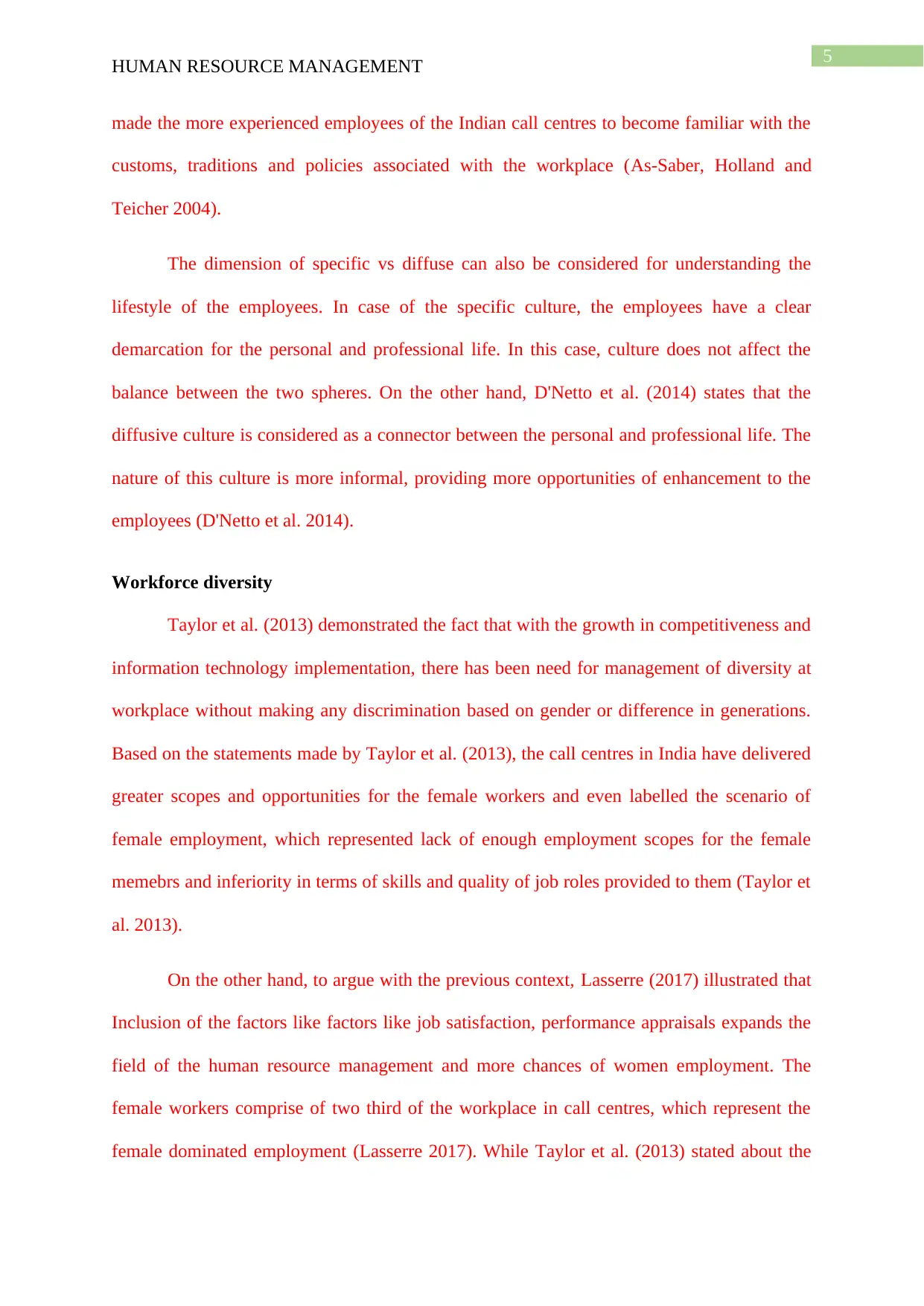
5
HUMAN RESOURCE MANAGEMENT
made the more experienced employees of the Indian call centres to become familiar with the
customs, traditions and policies associated with the workplace (As-Saber, Holland and
Teicher 2004).
The dimension of specific vs diffuse can also be considered for understanding the
lifestyle of the employees. In case of the specific culture, the employees have a clear
demarcation for the personal and professional life. In this case, culture does not affect the
balance between the two spheres. On the other hand, D'Netto et al. (2014) states that the
diffusive culture is considered as a connector between the personal and professional life. The
nature of this culture is more informal, providing more opportunities of enhancement to the
employees (D'Netto et al. 2014).
Workforce diversity
Taylor et al. (2013) demonstrated the fact that with the growth in competitiveness and
information technology implementation, there has been need for management of diversity at
workplace without making any discrimination based on gender or difference in generations.
Based on the statements made by Taylor et al. (2013), the call centres in India have delivered
greater scopes and opportunities for the female workers and even labelled the scenario of
female employment, which represented lack of enough employment scopes for the female
memebrs and inferiority in terms of skills and quality of job roles provided to them (Taylor et
al. 2013).
On the other hand, to argue with the previous context, Lasserre (2017) illustrated that
Inclusion of the factors like factors like job satisfaction, performance appraisals expands the
field of the human resource management and more chances of women employment. The
female workers comprise of two third of the workplace in call centres, which represent the
female dominated employment (Lasserre 2017). While Taylor et al. (2013) stated about the
HUMAN RESOURCE MANAGEMENT
made the more experienced employees of the Indian call centres to become familiar with the
customs, traditions and policies associated with the workplace (As-Saber, Holland and
Teicher 2004).
The dimension of specific vs diffuse can also be considered for understanding the
lifestyle of the employees. In case of the specific culture, the employees have a clear
demarcation for the personal and professional life. In this case, culture does not affect the
balance between the two spheres. On the other hand, D'Netto et al. (2014) states that the
diffusive culture is considered as a connector between the personal and professional life. The
nature of this culture is more informal, providing more opportunities of enhancement to the
employees (D'Netto et al. 2014).
Workforce diversity
Taylor et al. (2013) demonstrated the fact that with the growth in competitiveness and
information technology implementation, there has been need for management of diversity at
workplace without making any discrimination based on gender or difference in generations.
Based on the statements made by Taylor et al. (2013), the call centres in India have delivered
greater scopes and opportunities for the female workers and even labelled the scenario of
female employment, which represented lack of enough employment scopes for the female
memebrs and inferiority in terms of skills and quality of job roles provided to them (Taylor et
al. 2013).
On the other hand, to argue with the previous context, Lasserre (2017) illustrated that
Inclusion of the factors like factors like job satisfaction, performance appraisals expands the
field of the human resource management and more chances of women employment. The
female workers comprise of two third of the workplace in call centres, which represent the
female dominated employment (Lasserre 2017). While Taylor et al. (2013) stated about the
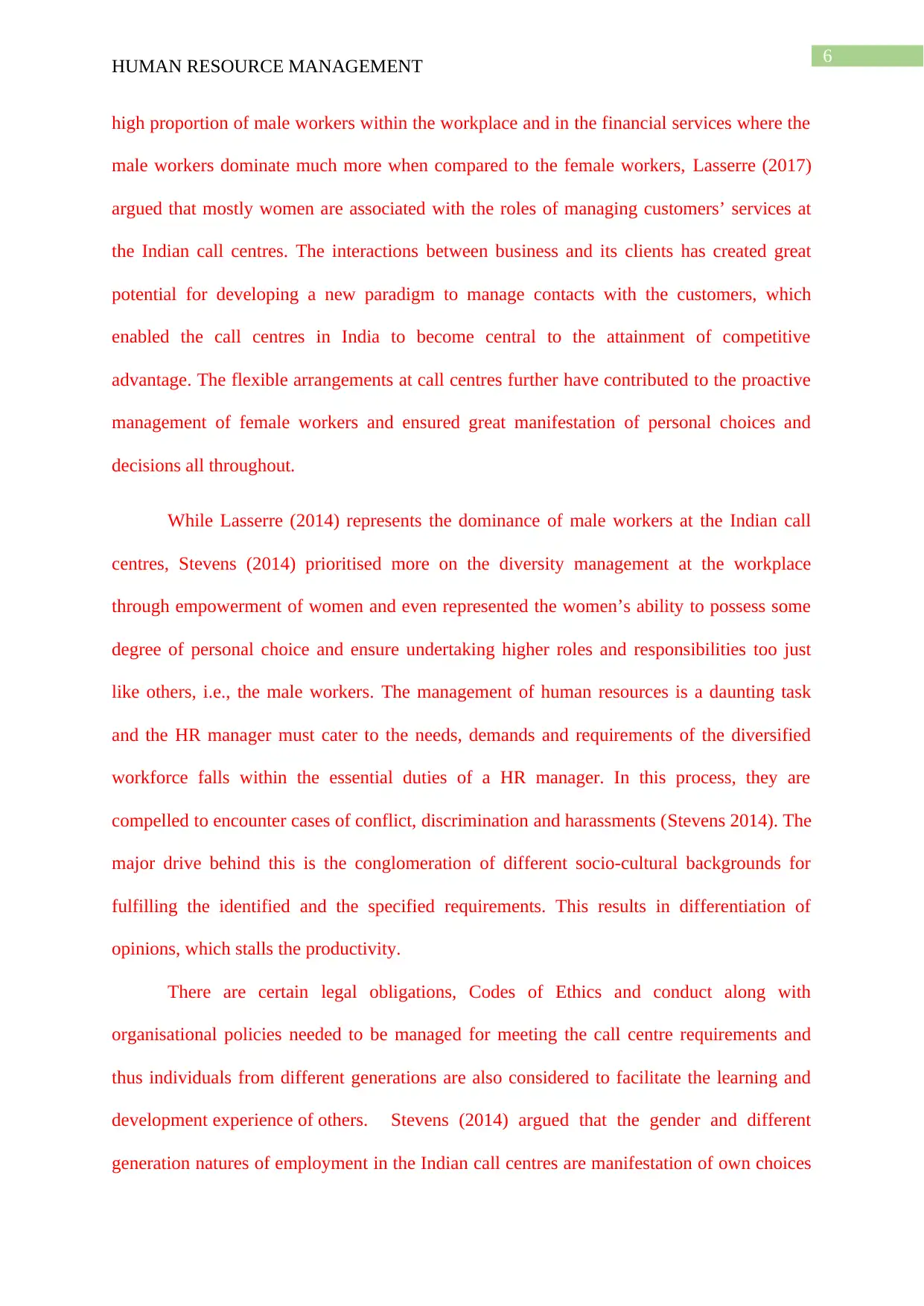
6
HUMAN RESOURCE MANAGEMENT
high proportion of male workers within the workplace and in the financial services where the
male workers dominate much more when compared to the female workers, Lasserre (2017)
argued that mostly women are associated with the roles of managing customers’ services at
the Indian call centres. The interactions between business and its clients has created great
potential for developing a new paradigm to manage contacts with the customers, which
enabled the call centres in India to become central to the attainment of competitive
advantage. The flexible arrangements at call centres further have contributed to the proactive
management of female workers and ensured great manifestation of personal choices and
decisions all throughout.
While Lasserre (2014) represents the dominance of male workers at the Indian call
centres, Stevens (2014) prioritised more on the diversity management at the workplace
through empowerment of women and even represented the women’s ability to possess some
degree of personal choice and ensure undertaking higher roles and responsibilities too just
like others, i.e., the male workers. The management of human resources is a daunting task
and the HR manager must cater to the needs, demands and requirements of the diversified
workforce falls within the essential duties of a HR manager. In this process, they are
compelled to encounter cases of conflict, discrimination and harassments (Stevens 2014). The
major drive behind this is the conglomeration of different socio-cultural backgrounds for
fulfilling the identified and the specified requirements. This results in differentiation of
opinions, which stalls the productivity.
There are certain legal obligations, Codes of Ethics and conduct along with
organisational policies needed to be managed for meeting the call centre requirements and
thus individuals from different generations are also considered to facilitate the learning and
development experience of others. Stevens (2014) argued that the gender and different
generation natures of employment in the Indian call centres are manifestation of own choices
HUMAN RESOURCE MANAGEMENT
high proportion of male workers within the workplace and in the financial services where the
male workers dominate much more when compared to the female workers, Lasserre (2017)
argued that mostly women are associated with the roles of managing customers’ services at
the Indian call centres. The interactions between business and its clients has created great
potential for developing a new paradigm to manage contacts with the customers, which
enabled the call centres in India to become central to the attainment of competitive
advantage. The flexible arrangements at call centres further have contributed to the proactive
management of female workers and ensured great manifestation of personal choices and
decisions all throughout.
While Lasserre (2014) represents the dominance of male workers at the Indian call
centres, Stevens (2014) prioritised more on the diversity management at the workplace
through empowerment of women and even represented the women’s ability to possess some
degree of personal choice and ensure undertaking higher roles and responsibilities too just
like others, i.e., the male workers. The management of human resources is a daunting task
and the HR manager must cater to the needs, demands and requirements of the diversified
workforce falls within the essential duties of a HR manager. In this process, they are
compelled to encounter cases of conflict, discrimination and harassments (Stevens 2014). The
major drive behind this is the conglomeration of different socio-cultural backgrounds for
fulfilling the identified and the specified requirements. This results in differentiation of
opinions, which stalls the productivity.
There are certain legal obligations, Codes of Ethics and conduct along with
organisational policies needed to be managed for meeting the call centre requirements and
thus individuals from different generations are also considered to facilitate the learning and
development experience of others. Stevens (2014) argued that the gender and different
generation natures of employment in the Indian call centres are manifestation of own choices
Paraphrase This Document
Need a fresh take? Get an instant paraphrase of this document with our AI Paraphraser
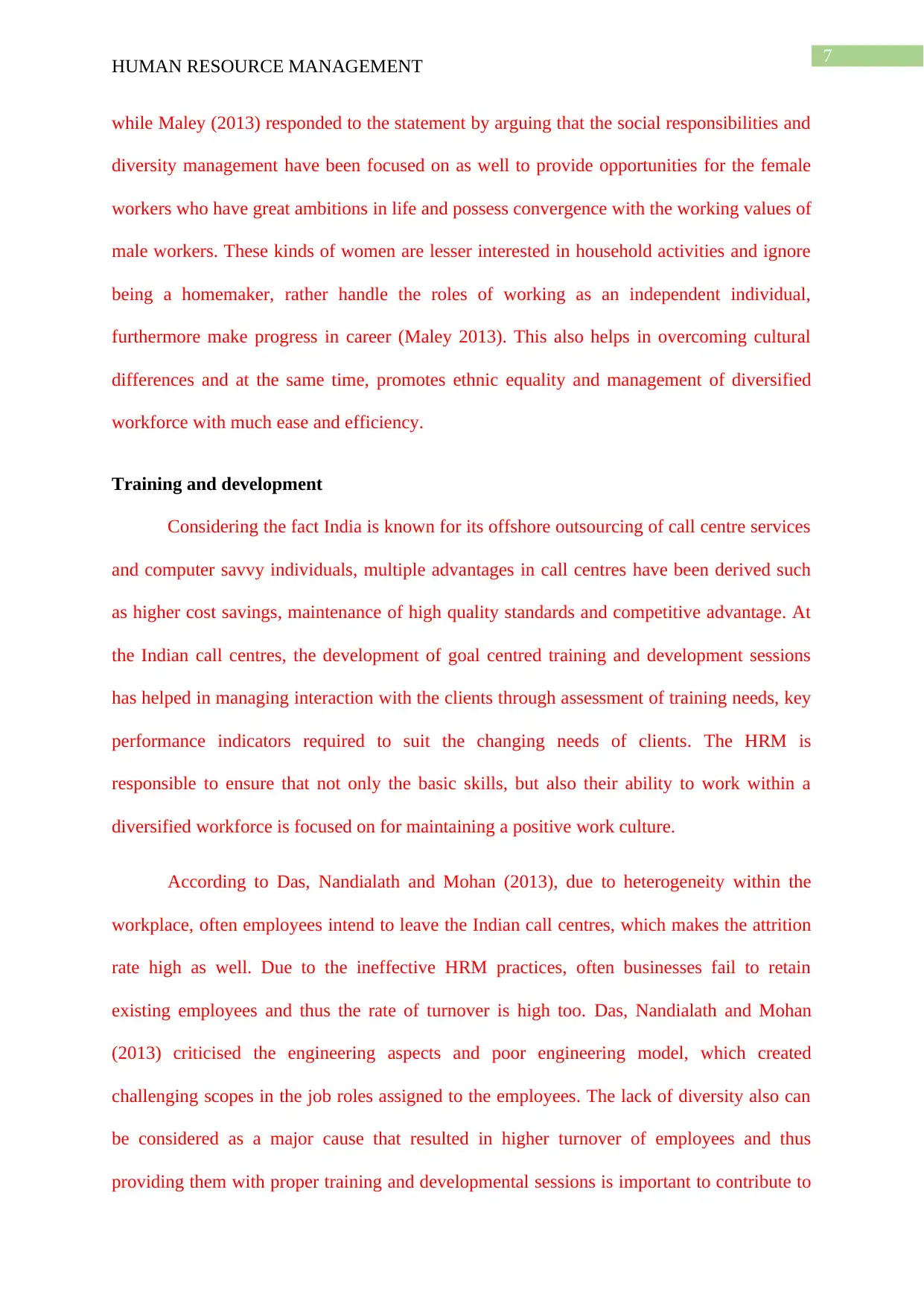
7
HUMAN RESOURCE MANAGEMENT
while Maley (2013) responded to the statement by arguing that the social responsibilities and
diversity management have been focused on as well to provide opportunities for the female
workers who have great ambitions in life and possess convergence with the working values of
male workers. These kinds of women are lesser interested in household activities and ignore
being a homemaker, rather handle the roles of working as an independent individual,
furthermore make progress in career (Maley 2013). This also helps in overcoming cultural
differences and at the same time, promotes ethnic equality and management of diversified
workforce with much ease and efficiency.
Training and development
Considering the fact India is known for its offshore outsourcing of call centre services
and computer savvy individuals, multiple advantages in call centres have been derived such
as higher cost savings, maintenance of high quality standards and competitive advantage. At
the Indian call centres, the development of goal centred training and development sessions
has helped in managing interaction with the clients through assessment of training needs, key
performance indicators required to suit the changing needs of clients. The HRM is
responsible to ensure that not only the basic skills, but also their ability to work within a
diversified workforce is focused on for maintaining a positive work culture.
According to Das, Nandialath and Mohan (2013), due to heterogeneity within the
workplace, often employees intend to leave the Indian call centres, which makes the attrition
rate high as well. Due to the ineffective HRM practices, often businesses fail to retain
existing employees and thus the rate of turnover is high too. Das, Nandialath and Mohan
(2013) criticised the engineering aspects and poor engineering model, which created
challenging scopes in the job roles assigned to the employees. The lack of diversity also can
be considered as a major cause that resulted in higher turnover of employees and thus
providing them with proper training and developmental sessions is important to contribute to
HUMAN RESOURCE MANAGEMENT
while Maley (2013) responded to the statement by arguing that the social responsibilities and
diversity management have been focused on as well to provide opportunities for the female
workers who have great ambitions in life and possess convergence with the working values of
male workers. These kinds of women are lesser interested in household activities and ignore
being a homemaker, rather handle the roles of working as an independent individual,
furthermore make progress in career (Maley 2013). This also helps in overcoming cultural
differences and at the same time, promotes ethnic equality and management of diversified
workforce with much ease and efficiency.
Training and development
Considering the fact India is known for its offshore outsourcing of call centre services
and computer savvy individuals, multiple advantages in call centres have been derived such
as higher cost savings, maintenance of high quality standards and competitive advantage. At
the Indian call centres, the development of goal centred training and development sessions
has helped in managing interaction with the clients through assessment of training needs, key
performance indicators required to suit the changing needs of clients. The HRM is
responsible to ensure that not only the basic skills, but also their ability to work within a
diversified workforce is focused on for maintaining a positive work culture.
According to Das, Nandialath and Mohan (2013), due to heterogeneity within the
workplace, often employees intend to leave the Indian call centres, which makes the attrition
rate high as well. Due to the ineffective HRM practices, often businesses fail to retain
existing employees and thus the rate of turnover is high too. Das, Nandialath and Mohan
(2013) criticised the engineering aspects and poor engineering model, which created
challenging scopes in the job roles assigned to the employees. The lack of diversity also can
be considered as a major cause that resulted in higher turnover of employees and thus
providing them with proper training and developmental sessions is important to contribute to
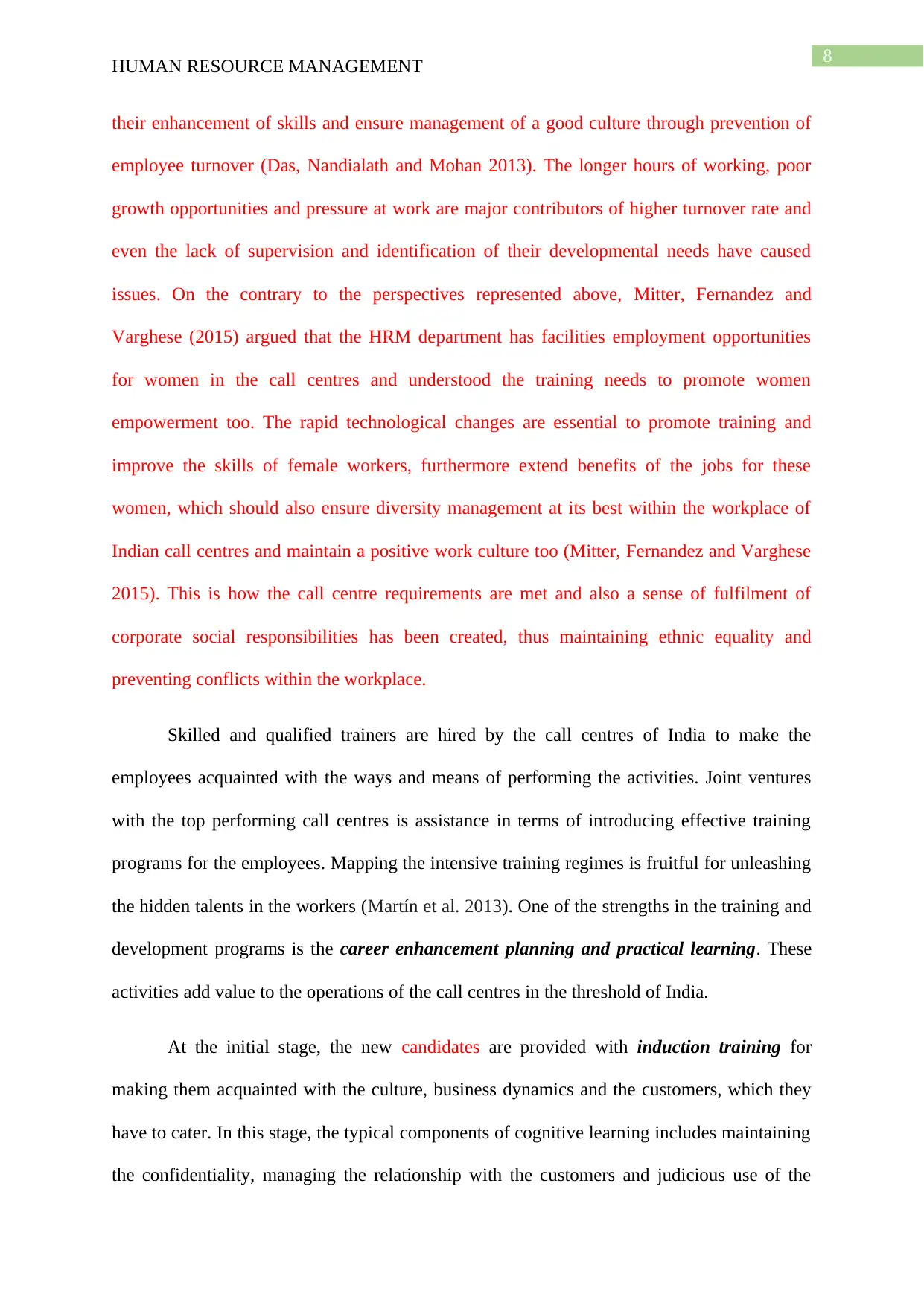
8
HUMAN RESOURCE MANAGEMENT
their enhancement of skills and ensure management of a good culture through prevention of
employee turnover (Das, Nandialath and Mohan 2013). The longer hours of working, poor
growth opportunities and pressure at work are major contributors of higher turnover rate and
even the lack of supervision and identification of their developmental needs have caused
issues. On the contrary to the perspectives represented above, Mitter, Fernandez and
Varghese (2015) argued that the HRM department has facilities employment opportunities
for women in the call centres and understood the training needs to promote women
empowerment too. The rapid technological changes are essential to promote training and
improve the skills of female workers, furthermore extend benefits of the jobs for these
women, which should also ensure diversity management at its best within the workplace of
Indian call centres and maintain a positive work culture too (Mitter, Fernandez and Varghese
2015). This is how the call centre requirements are met and also a sense of fulfilment of
corporate social responsibilities has been created, thus maintaining ethnic equality and
preventing conflicts within the workplace.
Skilled and qualified trainers are hired by the call centres of India to make the
employees acquainted with the ways and means of performing the activities. Joint ventures
with the top performing call centres is assistance in terms of introducing effective training
programs for the employees. Mapping the intensive training regimes is fruitful for unleashing
the hidden talents in the workers (Martín et al. 2013). One of the strengths in the training and
development programs is the career enhancement planning and practical learning. These
activities add value to the operations of the call centres in the threshold of India.
At the initial stage, the new candidates are provided with induction training for
making them acquainted with the culture, business dynamics and the customers, which they
have to cater. In this stage, the typical components of cognitive learning includes maintaining
the confidentiality, managing the relationship with the customers and judicious use of the
HUMAN RESOURCE MANAGEMENT
their enhancement of skills and ensure management of a good culture through prevention of
employee turnover (Das, Nandialath and Mohan 2013). The longer hours of working, poor
growth opportunities and pressure at work are major contributors of higher turnover rate and
even the lack of supervision and identification of their developmental needs have caused
issues. On the contrary to the perspectives represented above, Mitter, Fernandez and
Varghese (2015) argued that the HRM department has facilities employment opportunities
for women in the call centres and understood the training needs to promote women
empowerment too. The rapid technological changes are essential to promote training and
improve the skills of female workers, furthermore extend benefits of the jobs for these
women, which should also ensure diversity management at its best within the workplace of
Indian call centres and maintain a positive work culture too (Mitter, Fernandez and Varghese
2015). This is how the call centre requirements are met and also a sense of fulfilment of
corporate social responsibilities has been created, thus maintaining ethnic equality and
preventing conflicts within the workplace.
Skilled and qualified trainers are hired by the call centres of India to make the
employees acquainted with the ways and means of performing the activities. Joint ventures
with the top performing call centres is assistance in terms of introducing effective training
programs for the employees. Mapping the intensive training regimes is fruitful for unleashing
the hidden talents in the workers (Martín et al. 2013). One of the strengths in the training and
development programs is the career enhancement planning and practical learning. These
activities add value to the operations of the call centres in the threshold of India.
At the initial stage, the new candidates are provided with induction training for
making them acquainted with the culture, business dynamics and the customers, which they
have to cater. In this stage, the typical components of cognitive learning includes maintaining
the confidentiality, managing the relationship with the customers and judicious use of the
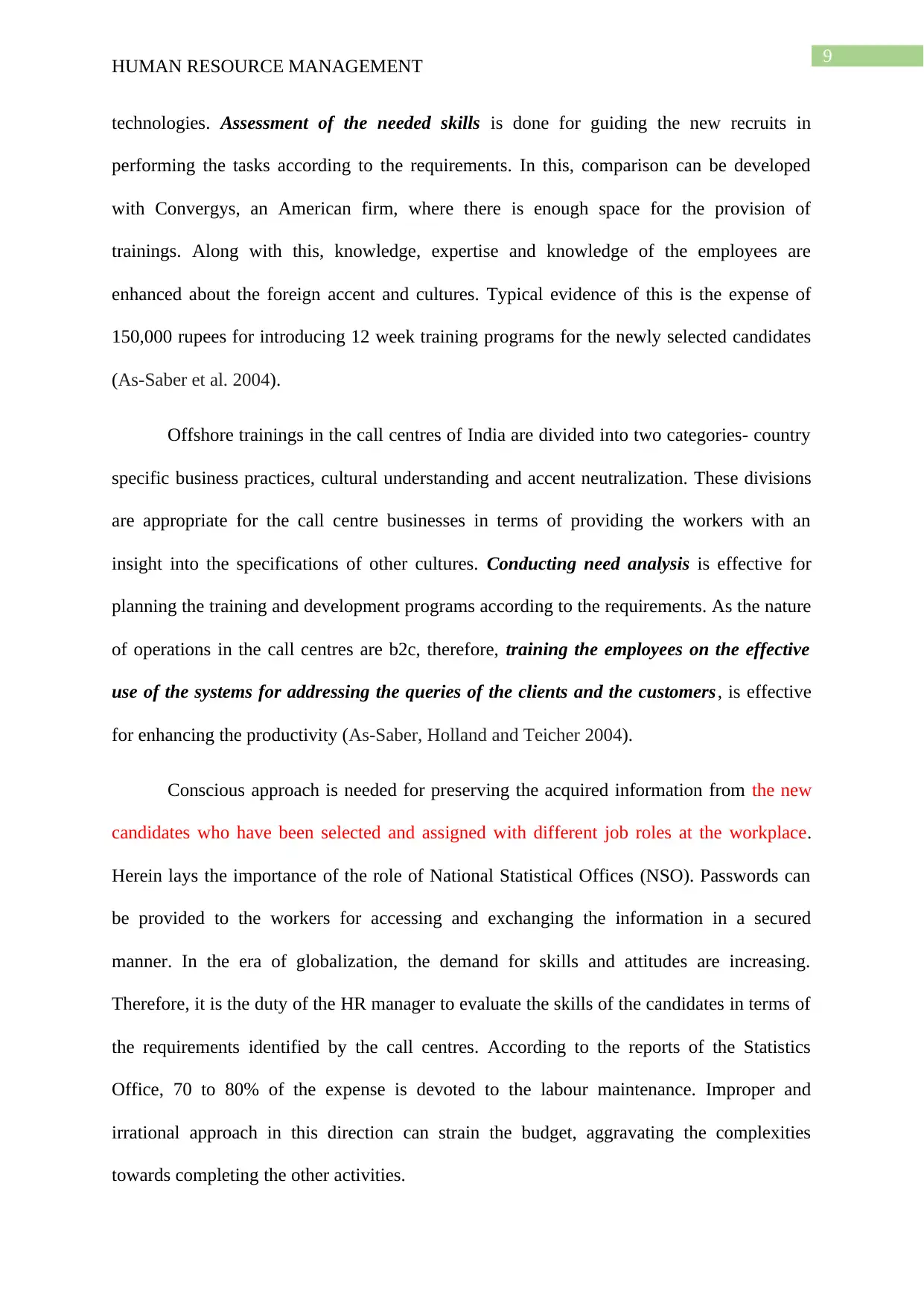
9
HUMAN RESOURCE MANAGEMENT
technologies. Assessment of the needed skills is done for guiding the new recruits in
performing the tasks according to the requirements. In this, comparison can be developed
with Convergys, an American firm, where there is enough space for the provision of
trainings. Along with this, knowledge, expertise and knowledge of the employees are
enhanced about the foreign accent and cultures. Typical evidence of this is the expense of
150,000 rupees for introducing 12 week training programs for the newly selected candidates
(As-Saber et al. 2004).
Offshore trainings in the call centres of India are divided into two categories- country
specific business practices, cultural understanding and accent neutralization. These divisions
are appropriate for the call centre businesses in terms of providing the workers with an
insight into the specifications of other cultures. Conducting need analysis is effective for
planning the training and development programs according to the requirements. As the nature
of operations in the call centres are b2c, therefore, training the employees on the effective
use of the systems for addressing the queries of the clients and the customers, is effective
for enhancing the productivity (As-Saber, Holland and Teicher 2004).
Conscious approach is needed for preserving the acquired information from the new
candidates who have been selected and assigned with different job roles at the workplace.
Herein lays the importance of the role of National Statistical Offices (NSO). Passwords can
be provided to the workers for accessing and exchanging the information in a secured
manner. In the era of globalization, the demand for skills and attitudes are increasing.
Therefore, it is the duty of the HR manager to evaluate the skills of the candidates in terms of
the requirements identified by the call centres. According to the reports of the Statistics
Office, 70 to 80% of the expense is devoted to the labour maintenance. Improper and
irrational approach in this direction can strain the budget, aggravating the complexities
towards completing the other activities.
HUMAN RESOURCE MANAGEMENT
technologies. Assessment of the needed skills is done for guiding the new recruits in
performing the tasks according to the requirements. In this, comparison can be developed
with Convergys, an American firm, where there is enough space for the provision of
trainings. Along with this, knowledge, expertise and knowledge of the employees are
enhanced about the foreign accent and cultures. Typical evidence of this is the expense of
150,000 rupees for introducing 12 week training programs for the newly selected candidates
(As-Saber et al. 2004).
Offshore trainings in the call centres of India are divided into two categories- country
specific business practices, cultural understanding and accent neutralization. These divisions
are appropriate for the call centre businesses in terms of providing the workers with an
insight into the specifications of other cultures. Conducting need analysis is effective for
planning the training and development programs according to the requirements. As the nature
of operations in the call centres are b2c, therefore, training the employees on the effective
use of the systems for addressing the queries of the clients and the customers, is effective
for enhancing the productivity (As-Saber, Holland and Teicher 2004).
Conscious approach is needed for preserving the acquired information from the new
candidates who have been selected and assigned with different job roles at the workplace.
Herein lays the importance of the role of National Statistical Offices (NSO). Passwords can
be provided to the workers for accessing and exchanging the information in a secured
manner. In the era of globalization, the demand for skills and attitudes are increasing.
Therefore, it is the duty of the HR manager to evaluate the skills of the candidates in terms of
the requirements identified by the call centres. According to the reports of the Statistics
Office, 70 to 80% of the expense is devoted to the labour maintenance. Improper and
irrational approach in this direction can strain the budget, aggravating the complexities
towards completing the other activities.
Secure Best Marks with AI Grader
Need help grading? Try our AI Grader for instant feedback on your assignments.
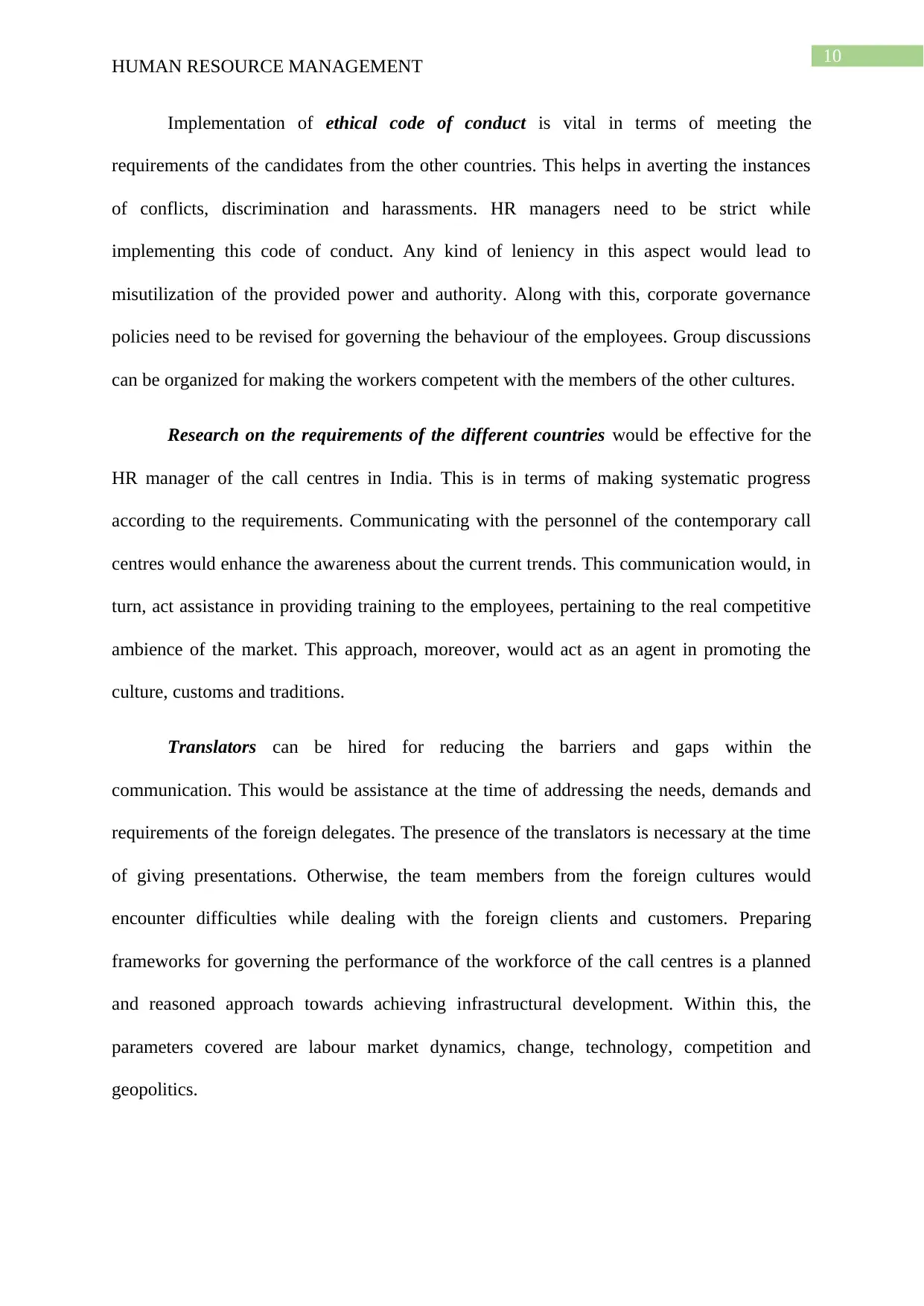
10
HUMAN RESOURCE MANAGEMENT
Implementation of ethical code of conduct is vital in terms of meeting the
requirements of the candidates from the other countries. This helps in averting the instances
of conflicts, discrimination and harassments. HR managers need to be strict while
implementing this code of conduct. Any kind of leniency in this aspect would lead to
misutilization of the provided power and authority. Along with this, corporate governance
policies need to be revised for governing the behaviour of the employees. Group discussions
can be organized for making the workers competent with the members of the other cultures.
Research on the requirements of the different countries would be effective for the
HR manager of the call centres in India. This is in terms of making systematic progress
according to the requirements. Communicating with the personnel of the contemporary call
centres would enhance the awareness about the current trends. This communication would, in
turn, act assistance in providing training to the employees, pertaining to the real competitive
ambience of the market. This approach, moreover, would act as an agent in promoting the
culture, customs and traditions.
Translators can be hired for reducing the barriers and gaps within the
communication. This would be assistance at the time of addressing the needs, demands and
requirements of the foreign delegates. The presence of the translators is necessary at the time
of giving presentations. Otherwise, the team members from the foreign cultures would
encounter difficulties while dealing with the foreign clients and customers. Preparing
frameworks for governing the performance of the workforce of the call centres is a planned
and reasoned approach towards achieving infrastructural development. Within this, the
parameters covered are labour market dynamics, change, technology, competition and
geopolitics.
HUMAN RESOURCE MANAGEMENT
Implementation of ethical code of conduct is vital in terms of meeting the
requirements of the candidates from the other countries. This helps in averting the instances
of conflicts, discrimination and harassments. HR managers need to be strict while
implementing this code of conduct. Any kind of leniency in this aspect would lead to
misutilization of the provided power and authority. Along with this, corporate governance
policies need to be revised for governing the behaviour of the employees. Group discussions
can be organized for making the workers competent with the members of the other cultures.
Research on the requirements of the different countries would be effective for the
HR manager of the call centres in India. This is in terms of making systematic progress
according to the requirements. Communicating with the personnel of the contemporary call
centres would enhance the awareness about the current trends. This communication would, in
turn, act assistance in providing training to the employees, pertaining to the real competitive
ambience of the market. This approach, moreover, would act as an agent in promoting the
culture, customs and traditions.
Translators can be hired for reducing the barriers and gaps within the
communication. This would be assistance at the time of addressing the needs, demands and
requirements of the foreign delegates. The presence of the translators is necessary at the time
of giving presentations. Otherwise, the team members from the foreign cultures would
encounter difficulties while dealing with the foreign clients and customers. Preparing
frameworks for governing the performance of the workforce of the call centres is a planned
and reasoned approach towards achieving infrastructural development. Within this, the
parameters covered are labour market dynamics, change, technology, competition and
geopolitics.
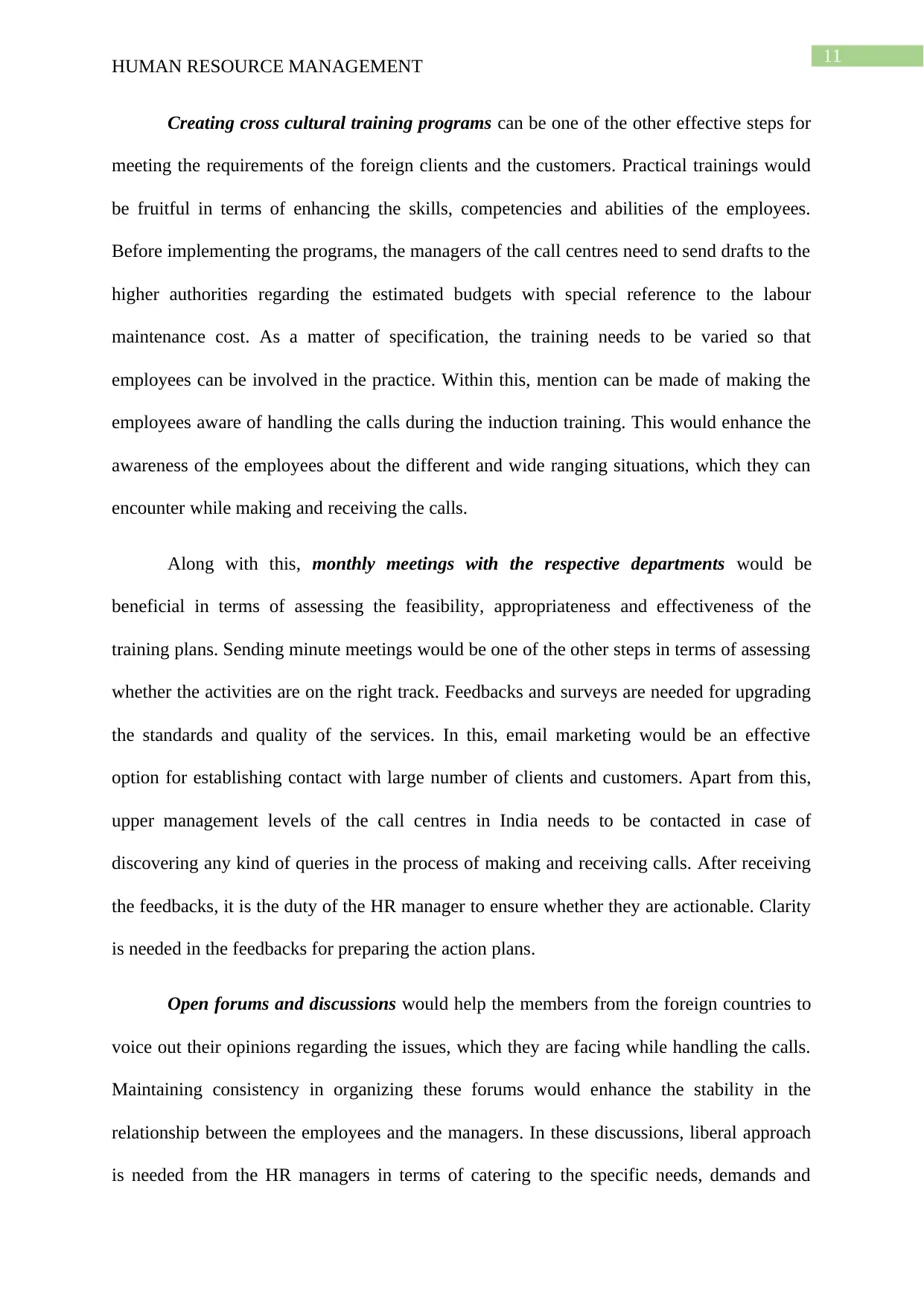
11
HUMAN RESOURCE MANAGEMENT
Creating cross cultural training programs can be one of the other effective steps for
meeting the requirements of the foreign clients and the customers. Practical trainings would
be fruitful in terms of enhancing the skills, competencies and abilities of the employees.
Before implementing the programs, the managers of the call centres need to send drafts to the
higher authorities regarding the estimated budgets with special reference to the labour
maintenance cost. As a matter of specification, the training needs to be varied so that
employees can be involved in the practice. Within this, mention can be made of making the
employees aware of handling the calls during the induction training. This would enhance the
awareness of the employees about the different and wide ranging situations, which they can
encounter while making and receiving the calls.
Along with this, monthly meetings with the respective departments would be
beneficial in terms of assessing the feasibility, appropriateness and effectiveness of the
training plans. Sending minute meetings would be one of the other steps in terms of assessing
whether the activities are on the right track. Feedbacks and surveys are needed for upgrading
the standards and quality of the services. In this, email marketing would be an effective
option for establishing contact with large number of clients and customers. Apart from this,
upper management levels of the call centres in India needs to be contacted in case of
discovering any kind of queries in the process of making and receiving calls. After receiving
the feedbacks, it is the duty of the HR manager to ensure whether they are actionable. Clarity
is needed in the feedbacks for preparing the action plans.
Open forums and discussions would help the members from the foreign countries to
voice out their opinions regarding the issues, which they are facing while handling the calls.
Maintaining consistency in organizing these forums would enhance the stability in the
relationship between the employees and the managers. In these discussions, liberal approach
is needed from the HR managers in terms of catering to the specific needs, demands and
HUMAN RESOURCE MANAGEMENT
Creating cross cultural training programs can be one of the other effective steps for
meeting the requirements of the foreign clients and the customers. Practical trainings would
be fruitful in terms of enhancing the skills, competencies and abilities of the employees.
Before implementing the programs, the managers of the call centres need to send drafts to the
higher authorities regarding the estimated budgets with special reference to the labour
maintenance cost. As a matter of specification, the training needs to be varied so that
employees can be involved in the practice. Within this, mention can be made of making the
employees aware of handling the calls during the induction training. This would enhance the
awareness of the employees about the different and wide ranging situations, which they can
encounter while making and receiving the calls.
Along with this, monthly meetings with the respective departments would be
beneficial in terms of assessing the feasibility, appropriateness and effectiveness of the
training plans. Sending minute meetings would be one of the other steps in terms of assessing
whether the activities are on the right track. Feedbacks and surveys are needed for upgrading
the standards and quality of the services. In this, email marketing would be an effective
option for establishing contact with large number of clients and customers. Apart from this,
upper management levels of the call centres in India needs to be contacted in case of
discovering any kind of queries in the process of making and receiving calls. After receiving
the feedbacks, it is the duty of the HR manager to ensure whether they are actionable. Clarity
is needed in the feedbacks for preparing the action plans.
Open forums and discussions would help the members from the foreign countries to
voice out their opinions regarding the issues, which they are facing while handling the calls.
Maintaining consistency in organizing these forums would enhance the stability in the
relationship between the employees and the managers. In these discussions, liberal approach
is needed from the HR managers in terms of catering to the specific needs, demands and
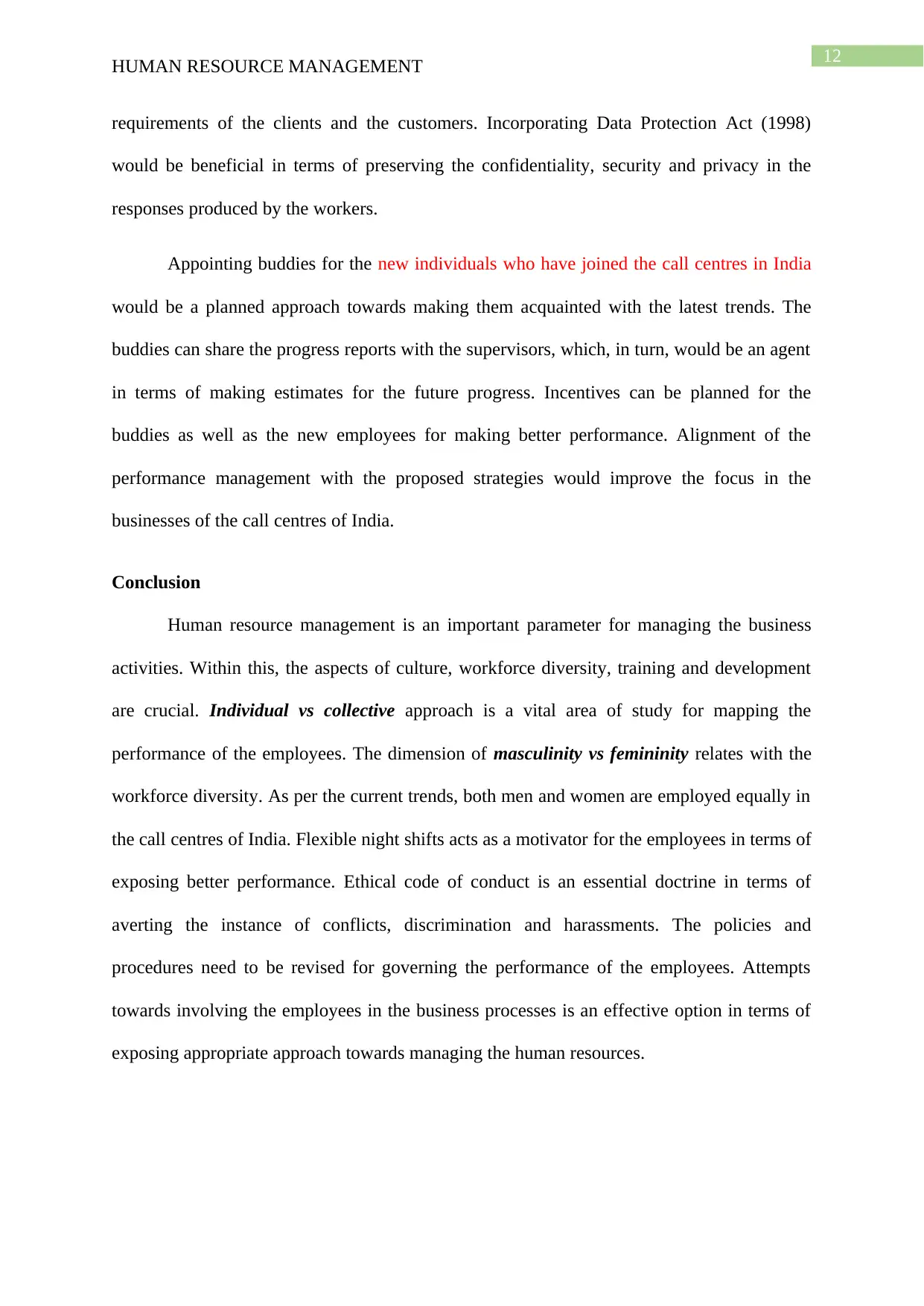
12
HUMAN RESOURCE MANAGEMENT
requirements of the clients and the customers. Incorporating Data Protection Act (1998)
would be beneficial in terms of preserving the confidentiality, security and privacy in the
responses produced by the workers.
Appointing buddies for the new individuals who have joined the call centres in India
would be a planned approach towards making them acquainted with the latest trends. The
buddies can share the progress reports with the supervisors, which, in turn, would be an agent
in terms of making estimates for the future progress. Incentives can be planned for the
buddies as well as the new employees for making better performance. Alignment of the
performance management with the proposed strategies would improve the focus in the
businesses of the call centres of India.
Conclusion
Human resource management is an important parameter for managing the business
activities. Within this, the aspects of culture, workforce diversity, training and development
are crucial. Individual vs collective approach is a vital area of study for mapping the
performance of the employees. The dimension of masculinity vs femininity relates with the
workforce diversity. As per the current trends, both men and women are employed equally in
the call centres of India. Flexible night shifts acts as a motivator for the employees in terms of
exposing better performance. Ethical code of conduct is an essential doctrine in terms of
averting the instance of conflicts, discrimination and harassments. The policies and
procedures need to be revised for governing the performance of the employees. Attempts
towards involving the employees in the business processes is an effective option in terms of
exposing appropriate approach towards managing the human resources.
HUMAN RESOURCE MANAGEMENT
requirements of the clients and the customers. Incorporating Data Protection Act (1998)
would be beneficial in terms of preserving the confidentiality, security and privacy in the
responses produced by the workers.
Appointing buddies for the new individuals who have joined the call centres in India
would be a planned approach towards making them acquainted with the latest trends. The
buddies can share the progress reports with the supervisors, which, in turn, would be an agent
in terms of making estimates for the future progress. Incentives can be planned for the
buddies as well as the new employees for making better performance. Alignment of the
performance management with the proposed strategies would improve the focus in the
businesses of the call centres of India.
Conclusion
Human resource management is an important parameter for managing the business
activities. Within this, the aspects of culture, workforce diversity, training and development
are crucial. Individual vs collective approach is a vital area of study for mapping the
performance of the employees. The dimension of masculinity vs femininity relates with the
workforce diversity. As per the current trends, both men and women are employed equally in
the call centres of India. Flexible night shifts acts as a motivator for the employees in terms of
exposing better performance. Ethical code of conduct is an essential doctrine in terms of
averting the instance of conflicts, discrimination and harassments. The policies and
procedures need to be revised for governing the performance of the employees. Attempts
towards involving the employees in the business processes is an effective option in terms of
exposing appropriate approach towards managing the human resources.
Paraphrase This Document
Need a fresh take? Get an instant paraphrase of this document with our AI Paraphraser
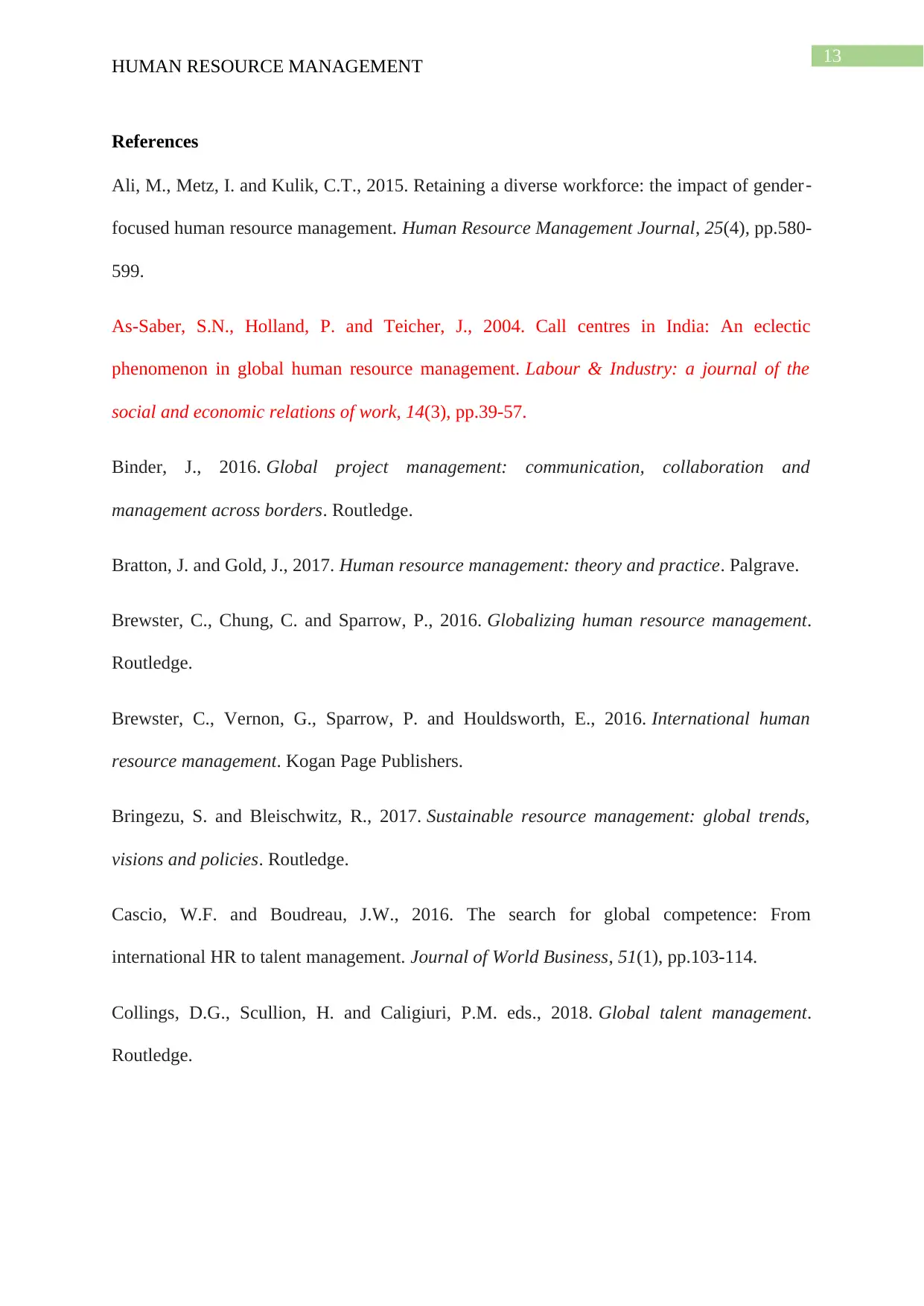
13
HUMAN RESOURCE MANAGEMENT
References
Ali, M., Metz, I. and Kulik, C.T., 2015. Retaining a diverse workforce: the impact of gender‐
focused human resource management. Human Resource Management Journal, 25(4), pp.580-
599.
As-Saber, S.N., Holland, P. and Teicher, J., 2004. Call centres in India: An eclectic
phenomenon in global human resource management. Labour & Industry: a journal of the
social and economic relations of work, 14(3), pp.39-57.
Binder, J., 2016. Global project management: communication, collaboration and
management across borders. Routledge.
Bratton, J. and Gold, J., 2017. Human resource management: theory and practice. Palgrave.
Brewster, C., Chung, C. and Sparrow, P., 2016. Globalizing human resource management.
Routledge.
Brewster, C., Vernon, G., Sparrow, P. and Houldsworth, E., 2016. International human
resource management. Kogan Page Publishers.
Bringezu, S. and Bleischwitz, R., 2017. Sustainable resource management: global trends,
visions and policies. Routledge.
Cascio, W.F. and Boudreau, J.W., 2016. The search for global competence: From
international HR to talent management. Journal of World Business, 51(1), pp.103-114.
Collings, D.G., Scullion, H. and Caligiuri, P.M. eds., 2018. Global talent management.
Routledge.
HUMAN RESOURCE MANAGEMENT
References
Ali, M., Metz, I. and Kulik, C.T., 2015. Retaining a diverse workforce: the impact of gender‐
focused human resource management. Human Resource Management Journal, 25(4), pp.580-
599.
As-Saber, S.N., Holland, P. and Teicher, J., 2004. Call centres in India: An eclectic
phenomenon in global human resource management. Labour & Industry: a journal of the
social and economic relations of work, 14(3), pp.39-57.
Binder, J., 2016. Global project management: communication, collaboration and
management across borders. Routledge.
Bratton, J. and Gold, J., 2017. Human resource management: theory and practice. Palgrave.
Brewster, C., Chung, C. and Sparrow, P., 2016. Globalizing human resource management.
Routledge.
Brewster, C., Vernon, G., Sparrow, P. and Houldsworth, E., 2016. International human
resource management. Kogan Page Publishers.
Bringezu, S. and Bleischwitz, R., 2017. Sustainable resource management: global trends,
visions and policies. Routledge.
Cascio, W.F. and Boudreau, J.W., 2016. The search for global competence: From
international HR to talent management. Journal of World Business, 51(1), pp.103-114.
Collings, D.G., Scullion, H. and Caligiuri, P.M. eds., 2018. Global talent management.
Routledge.
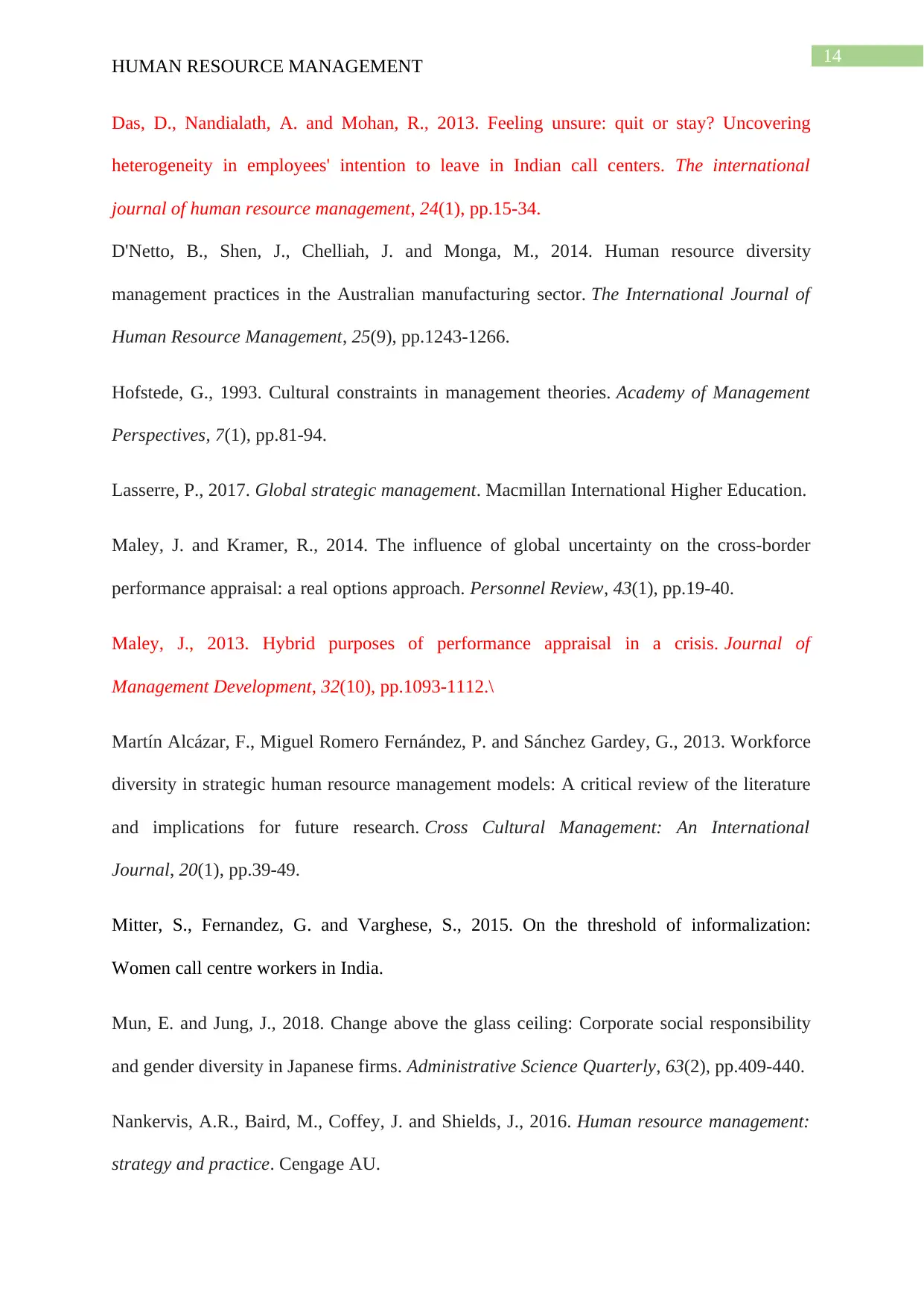
14
HUMAN RESOURCE MANAGEMENT
Das, D., Nandialath, A. and Mohan, R., 2013. Feeling unsure: quit or stay? Uncovering
heterogeneity in employees' intention to leave in Indian call centers. The international
journal of human resource management, 24(1), pp.15-34.
D'Netto, B., Shen, J., Chelliah, J. and Monga, M., 2014. Human resource diversity
management practices in the Australian manufacturing sector. The International Journal of
Human Resource Management, 25(9), pp.1243-1266.
Hofstede, G., 1993. Cultural constraints in management theories. Academy of Management
Perspectives, 7(1), pp.81-94.
Lasserre, P., 2017. Global strategic management. Macmillan International Higher Education.
Maley, J. and Kramer, R., 2014. The influence of global uncertainty on the cross-border
performance appraisal: a real options approach. Personnel Review, 43(1), pp.19-40.
Maley, J., 2013. Hybrid purposes of performance appraisal in a crisis. Journal of
Management Development, 32(10), pp.1093-1112.\
Martín Alcázar, F., Miguel Romero Fernández, P. and Sánchez Gardey, G., 2013. Workforce
diversity in strategic human resource management models: A critical review of the literature
and implications for future research. Cross Cultural Management: An International
Journal, 20(1), pp.39-49.
Mitter, S., Fernandez, G. and Varghese, S., 2015. On the threshold of informalization:
Women call centre workers in India.
Mun, E. and Jung, J., 2018. Change above the glass ceiling: Corporate social responsibility
and gender diversity in Japanese firms. Administrative Science Quarterly, 63(2), pp.409-440.
Nankervis, A.R., Baird, M., Coffey, J. and Shields, J., 2016. Human resource management:
strategy and practice. Cengage AU.
HUMAN RESOURCE MANAGEMENT
Das, D., Nandialath, A. and Mohan, R., 2013. Feeling unsure: quit or stay? Uncovering
heterogeneity in employees' intention to leave in Indian call centers. The international
journal of human resource management, 24(1), pp.15-34.
D'Netto, B., Shen, J., Chelliah, J. and Monga, M., 2014. Human resource diversity
management practices in the Australian manufacturing sector. The International Journal of
Human Resource Management, 25(9), pp.1243-1266.
Hofstede, G., 1993. Cultural constraints in management theories. Academy of Management
Perspectives, 7(1), pp.81-94.
Lasserre, P., 2017. Global strategic management. Macmillan International Higher Education.
Maley, J. and Kramer, R., 2014. The influence of global uncertainty on the cross-border
performance appraisal: a real options approach. Personnel Review, 43(1), pp.19-40.
Maley, J., 2013. Hybrid purposes of performance appraisal in a crisis. Journal of
Management Development, 32(10), pp.1093-1112.\
Martín Alcázar, F., Miguel Romero Fernández, P. and Sánchez Gardey, G., 2013. Workforce
diversity in strategic human resource management models: A critical review of the literature
and implications for future research. Cross Cultural Management: An International
Journal, 20(1), pp.39-49.
Mitter, S., Fernandez, G. and Varghese, S., 2015. On the threshold of informalization:
Women call centre workers in India.
Mun, E. and Jung, J., 2018. Change above the glass ceiling: Corporate social responsibility
and gender diversity in Japanese firms. Administrative Science Quarterly, 63(2), pp.409-440.
Nankervis, A.R., Baird, M., Coffey, J. and Shields, J., 2016. Human resource management:
strategy and practice. Cengage AU.
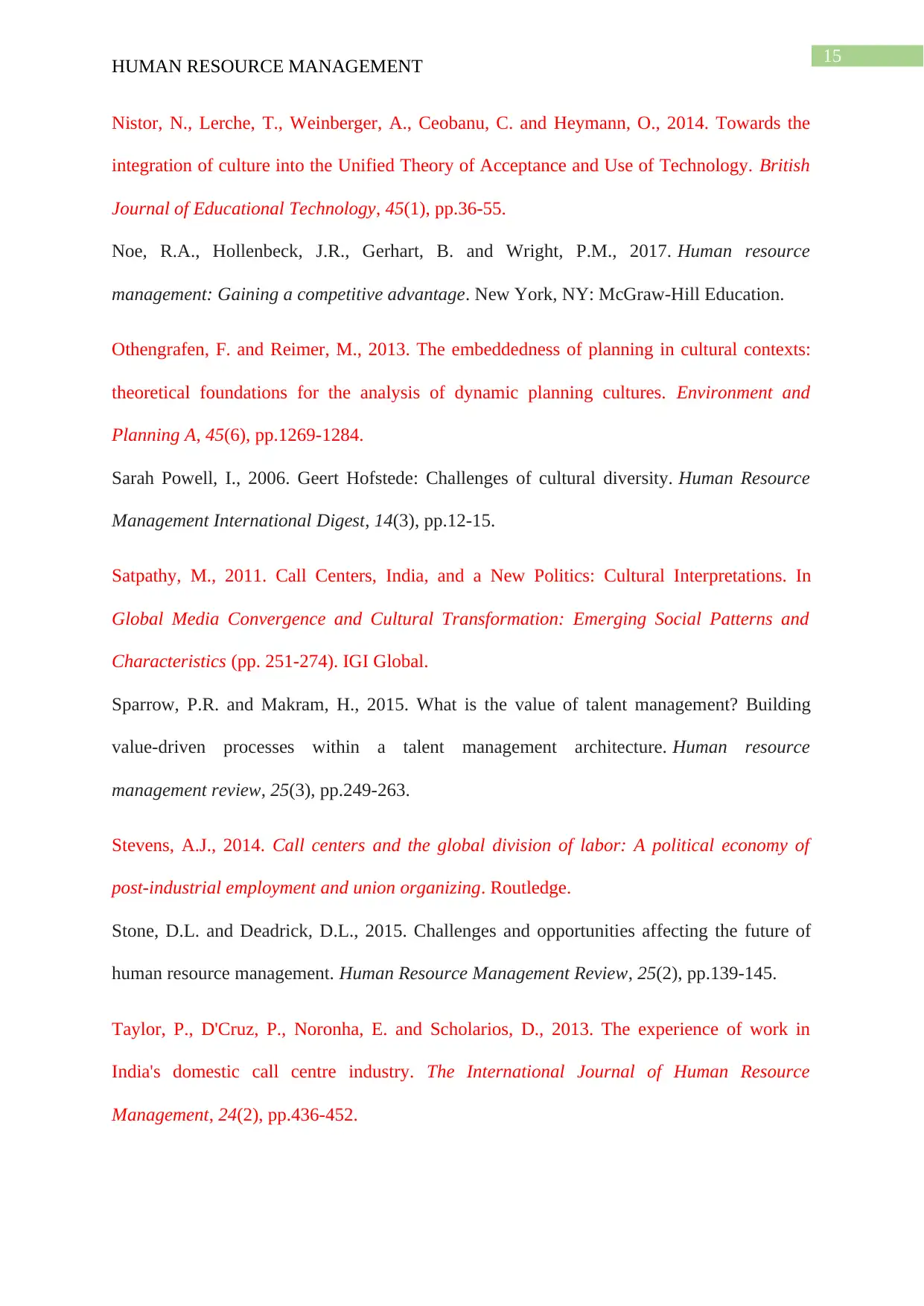
15
HUMAN RESOURCE MANAGEMENT
Nistor, N., Lerche, T., Weinberger, A., Ceobanu, C. and Heymann, O., 2014. Towards the
integration of culture into the Unified Theory of Acceptance and Use of Technology. British
Journal of Educational Technology, 45(1), pp.36-55.
Noe, R.A., Hollenbeck, J.R., Gerhart, B. and Wright, P.M., 2017. Human resource
management: Gaining a competitive advantage. New York, NY: McGraw-Hill Education.
Othengrafen, F. and Reimer, M., 2013. The embeddedness of planning in cultural contexts:
theoretical foundations for the analysis of dynamic planning cultures. Environment and
Planning A, 45(6), pp.1269-1284.
Sarah Powell, I., 2006. Geert Hofstede: Challenges of cultural diversity. Human Resource
Management International Digest, 14(3), pp.12-15.
Satpathy, M., 2011. Call Centers, India, and a New Politics: Cultural Interpretations. In
Global Media Convergence and Cultural Transformation: Emerging Social Patterns and
Characteristics (pp. 251-274). IGI Global.
Sparrow, P.R. and Makram, H., 2015. What is the value of talent management? Building
value-driven processes within a talent management architecture. Human resource
management review, 25(3), pp.249-263.
Stevens, A.J., 2014. Call centers and the global division of labor: A political economy of
post-industrial employment and union organizing. Routledge.
Stone, D.L. and Deadrick, D.L., 2015. Challenges and opportunities affecting the future of
human resource management. Human Resource Management Review, 25(2), pp.139-145.
Taylor, P., D'Cruz, P., Noronha, E. and Scholarios, D., 2013. The experience of work in
India's domestic call centre industry. The International Journal of Human Resource
Management, 24(2), pp.436-452.
HUMAN RESOURCE MANAGEMENT
Nistor, N., Lerche, T., Weinberger, A., Ceobanu, C. and Heymann, O., 2014. Towards the
integration of culture into the Unified Theory of Acceptance and Use of Technology. British
Journal of Educational Technology, 45(1), pp.36-55.
Noe, R.A., Hollenbeck, J.R., Gerhart, B. and Wright, P.M., 2017. Human resource
management: Gaining a competitive advantage. New York, NY: McGraw-Hill Education.
Othengrafen, F. and Reimer, M., 2013. The embeddedness of planning in cultural contexts:
theoretical foundations for the analysis of dynamic planning cultures. Environment and
Planning A, 45(6), pp.1269-1284.
Sarah Powell, I., 2006. Geert Hofstede: Challenges of cultural diversity. Human Resource
Management International Digest, 14(3), pp.12-15.
Satpathy, M., 2011. Call Centers, India, and a New Politics: Cultural Interpretations. In
Global Media Convergence and Cultural Transformation: Emerging Social Patterns and
Characteristics (pp. 251-274). IGI Global.
Sparrow, P.R. and Makram, H., 2015. What is the value of talent management? Building
value-driven processes within a talent management architecture. Human resource
management review, 25(3), pp.249-263.
Stevens, A.J., 2014. Call centers and the global division of labor: A political economy of
post-industrial employment and union organizing. Routledge.
Stone, D.L. and Deadrick, D.L., 2015. Challenges and opportunities affecting the future of
human resource management. Human Resource Management Review, 25(2), pp.139-145.
Taylor, P., D'Cruz, P., Noronha, E. and Scholarios, D., 2013. The experience of work in
India's domestic call centre industry. The International Journal of Human Resource
Management, 24(2), pp.436-452.
1 out of 16
Related Documents
Your All-in-One AI-Powered Toolkit for Academic Success.
+13062052269
info@desklib.com
Available 24*7 on WhatsApp / Email
![[object Object]](/_next/static/media/star-bottom.7253800d.svg)
Unlock your academic potential
© 2024 | Zucol Services PVT LTD | All rights reserved.





